An International Tour to Spain, to the Pyrenees and steppes of the north, arranged in association with our friends at Oriole Birding. Our first foreign trip for two years, hopefully our International Tours can now resume uninterrupted – we have more 2022 trips planned to Extremadura in May, the Danube Delta in early June and The Gambia in November, and are planning to be back in the Pyrenees in 2023. If you like the sound of what you read here and think you want to join us on any of these future trips, please get in touch.
25th February
Our flight from Gatwick to Barcelona arrived early and we emerged to find the weather bright and mild. We met up with local guide Carles and headed over to the Enterprise car rental desk in the car park. Unfortunately, when we arrived, we were told that despite having a confirmation number, our reserved minibus had been given to someone else and they had no other available. The person on the desk was particularly unhelpful and at first refused to offer us any alternative, and it was only after complaining direct to Enterprise in the US that suddenly we were offered two cars. Thankfully, with two of us to guide and drive anyway we could fit everyone in, so we decided to take that option and not waste any more time.
It was a relief to get underway, albeit a little later than planned. It was quite a drive up into the Pyrenees, so we made our way up to a site around two hours north of Barcelona. We pulled up on the top of a rocky outcrop, where a small kettle of Griffon Vultures were circling overhead. As we got out, we noticed a Peregrine was circling with them too.
As we walked out across the rocks towards the edge, a couple of Black Redstarts flicked off ahead of us, flashing their orange-red tails. A Stonechat perched up on the bushes nearby. It was a great view looking out over the edge at the valley below. More Griffon Vultures were patrolling up and down the cliff face and we could see several on ledges below us.
We followed the edge of the cliff round through the thorny scrub. There were few small birds here at first, but one of the group looked up to the Griffons still circling overhead and noticed a stork with them now. Even better, it was a Black Stork, a very scarce bird here. It was probably migrating north and after a couple of minutes circling it broke off into a long glide and disappeared over the hillside. For those with an interest in flora, there were some smart dwarf Narcissus already in flower, growing from clefts in the rocks.
Continuing round the top of the cliffs, we noticed some movement on the ground ahead of us, an Alpine Accentor, our target bird here. As we stopped to watch, we realised there were several of them feeding there. Something spooked them, and they dropped over the cliff edge but after a couple of minutes, they flew back up and resumed feeding. We had great views of them now, at least five Alpine Accentors. Fantastic!
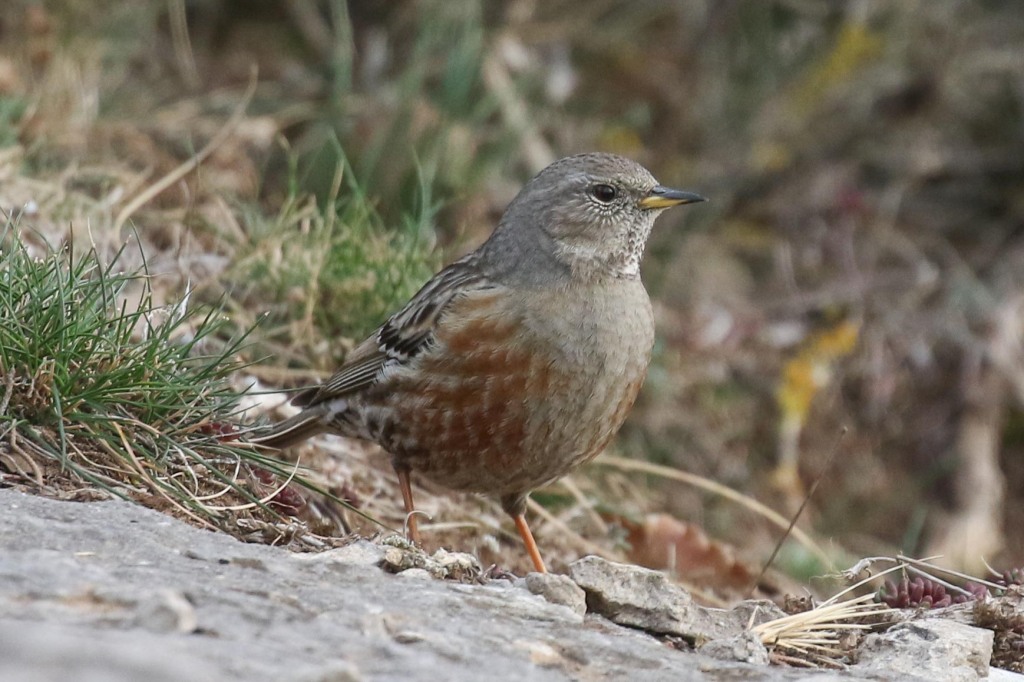
As we walked back to the cars, a flock of about twenty Red-billed Choughs flew down from the hillside behind and across in front of us, before dropping over the edge of the cliffs, followed shortly afterwards by a few more.
It was late afternoon already and we still had over two hours to drive to our accommodation for the night, so we climbed back into the vehicles and set off. After wrestling with the Friday night traffic heading up into the Pyrenees from Barcelona, we had a quick stop at our base of the night, enough time for some of the group to catch up with the resident Beech Marten coming to the feeding tables. Then it was out to a local restaurant for an evening meal and time for bed after a tiring journey.
26th February
After breakfast, we packed our bags and loaded up before setting off to explore the Catalan Pyrenees. It was a beautiful sunny morning, and a succession of hot air balloons were rising up from the valley below. We headed up towards a nearby ski resort, which was busy with traffic and skiers today, before taking a quieter road out of town and up through the trees. We made our way on to a more open area of hillside towards the top of the tree line, where we parked and got out.
Our main target here this morning was Citril Finch. There were lots of Chaffinches in the trees, and a particularly bright male Greenfinch perched in the top of a pine catching the sun did a good passing impression but was not what we were looking for. We walked down along the road to an open clearing and stopped to scan. Our luck was in! We didn’t have to wait too long before four Citril Finches flew in behind us and landed on a fence. We had good views of them through the scopes, bright yellowish below, greener above, with a grey shawl around the nape and well-marked wingbars, before they flew again, disappearing off over the trees.
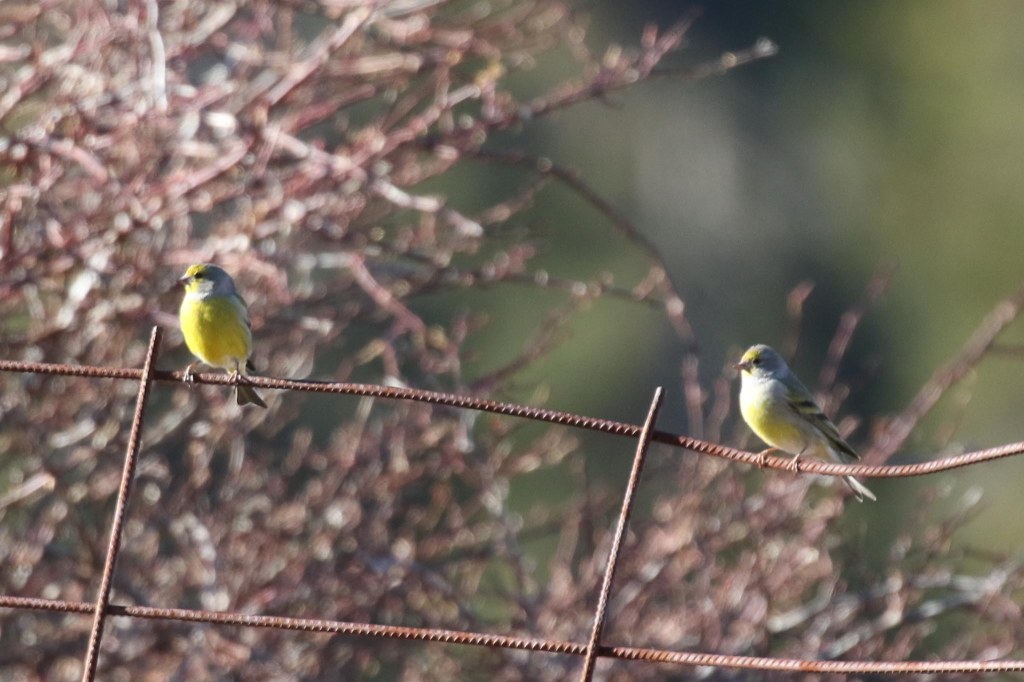
We walked further down through the pines, to see if we could refind them. There were Common Crossbills singing now, and we had good views of several perched in the trees, and a couple of males coming to pick salt or grit from the middle of the road. A pair of Goldcrests flitted through the trees and we had good views of a pair of Crested Tits and a pair of Short-toed Treecreepers here now.
Making our way back up to the clearing, two Citril Finches were further back perched up in the bushes in the middle now. It was lovely bright mountain light and they shone through the scopes. A Rock Sparrow flew up and landed in the top of a bare tree just behind.
After a very successful first stop, we walked back up to the cars and drove back round to the ski resort. It was still very busy, but we found somewhere to park and joined the queue of skiers to take the cable car up to the top. There were a couple of Grey Partridges on the slope below as we rode up to above 2,500m.
We had a tip off that some Snowfinches had been here in the last couple of days but there was no sign of them now. It has been very mild in the Pyrenees this year, which means some of the high altitude species which move lower in the winter have already returned back up. We could really appreciate that now looking at the ski slopes, which were vary patchy and even at this high altitude, large areas of the tops were already completely free of snow.
We walked round the rocks, scanning the slopes below, before finding a nice spot to sit and eat our lunch in the sunshine. A large flock of Alpine Choughs spiralled up below us and a little further round we found them feeding on an open grassy area still some way down. We looked down on the Griffon Vultures which were thermalling up in the warming air. A Lammergeier flew across below us – a bit distant but nice to get our first one of the trip.
The first Pyrenean Chamois we spotted was a model one on the edge of the ski slope, but we then noticed four real ones on a more distant hilltop. Over lunch, we found quite a few more hiding in the shade of the rocks on the slopes or resting on the snow. It was probably too warm for them in the sunshine! On the way back down in the cable car, a couple of Alpine Choughs were perched on the top of one of the pylons as we passed underneath.
We had a long drive west this afternoon. As we dropped down along the motorway towards Barcelona, we saw several Red Kites and our first Crag Martins over the road. After turning towards Lleida, the surprise of the day was a Monk Parakeet which flew over the motorway. It turns out there is a small resident population established here.
When we eventually got out onto the steppes, flocks of Skylarks and a couple of pairs of Crested Larks came up from the fields beside the road. We stopped and got out. The jangling of Corn Buntings singing was all around and our first good view of a Spotless Starling was perched in a flowering almond tree nearby. We noticed one of the tyres needed air, so we made our way back round to the nearby town to fill it up and enjoy a quick coffee break. Then we made our way back out onto the steppes along a different track.
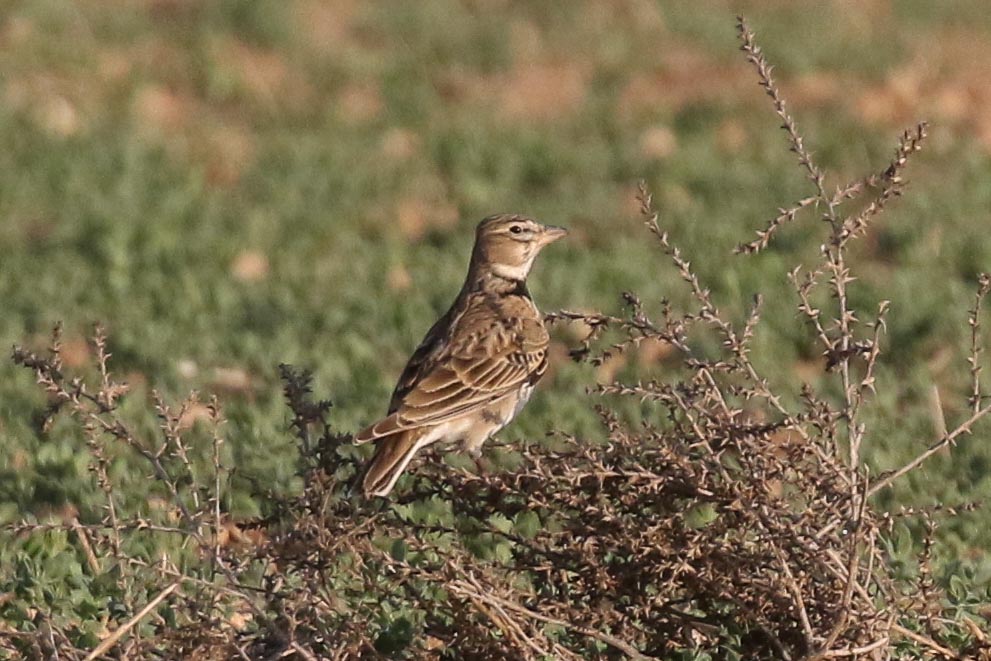
There were lots of Calandra Larks now, singing & song flighting all around us, so we stopped for a closer look and to listen. Continuing on, a pair of Little Owls on a ruined barn ahead of us dropped in as we approached and an Iberian Grey Shrike was perched on the top of a bush by the road. We were hoping to find Little Bustards here, but there was no sign of them now, just several rocks doing a passable impression until we stopped to look properly!
We stopped to look at a Peregrine, which was perched on a tree stump in the middle of the field. While the group were watching that, we walked back up the road scanning and persistence paid off, as we finally found a single Little Bustard a couple of fields over. It was not particularly close but a good view through the scope and a relief to find one, as the afternoon was getting on. We drove round to see if we could get a little closer, but the Little Bustard flew off before we could get there.
The dam had broken now! Just a little further on, we spotted a larger flock of Little Bustards in the distance and we drove round to where we could get the scopes on them. We counted 68 Little Bustards in the group, great to see. Not long ago, you could find flocks of several hundred Little Bustards here in the winter but they are declining very rapidly all over Spain and France due to agricultural intensification, so a flock as large as this is now a real treat to see.
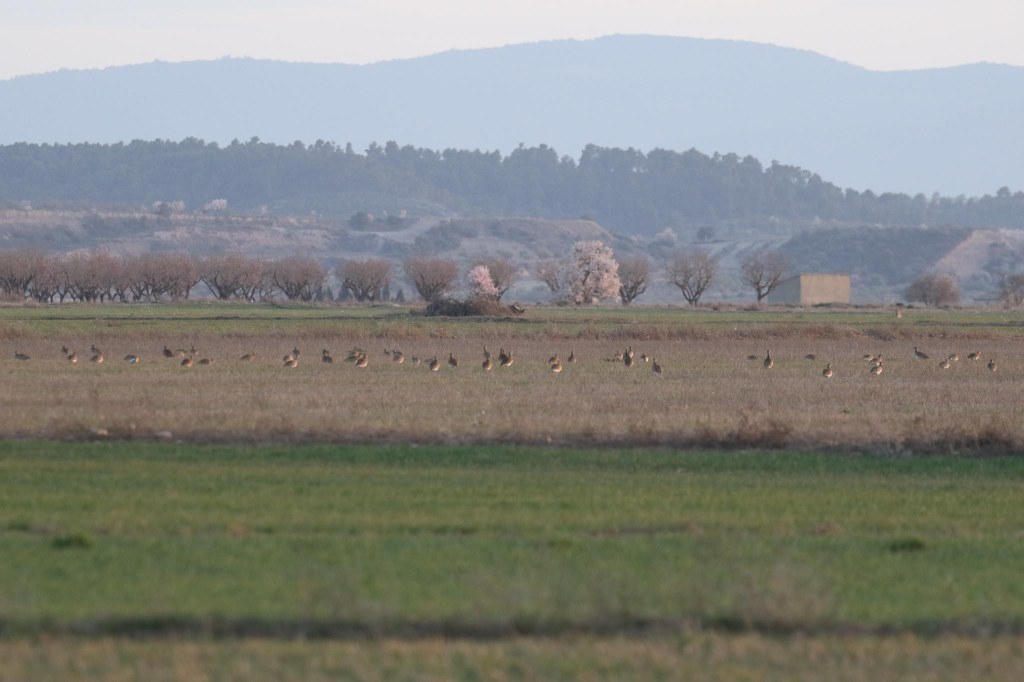
The light was starting to go and we still had another long drive to our base for the next few nights, so we had to tear ourselves away. A Marsh Harrier came up from the field by the main road and we had one last quick stop for an Iberian Green Woodpecker in some nearby trees before we got properly underway. It was after 8pm by the time we arrived, but we found a warm welcome and a delicious home-cooked meal of local cuisine waiting for us once we had settled in.
27th February
After breakfast this morning, we drove up to Vadiello. On the way, a Hawfinch was perched in the trees by the road and a Sardinian Warbler was calling nearby. Along the road in towards the dam, we pulled up to look in the two quarries, but there was no sign of any Wallcreepers here today. A short stop a little further up produced a small flock of Long-tailed Tits which moved quickly through the bushes.
It was rather cool and cloudy this morning and from the car park below the dam we could see lots of Griffon Vultures perched high up on the cliffs, waiting for it to warm up. We walked up to the dam and stopped to scan the rocks all around. A small herd of goats walked along the road and climbed straight up the rock face opposite. We admired their climbing ability! A Lammergeier appeared over the hillside beyond the water now, but disappeared round behind before we could all get onto it. Thankfully it reappeared after a few seconds back around the front of the hill and was now joined by an Egyptian Vulture – nice to see the two of them together. The Lammergeier landed, and we could get it in the scope now – we could even see its ‘beard’ from which it derives its alternative name, Bearded Vulture.
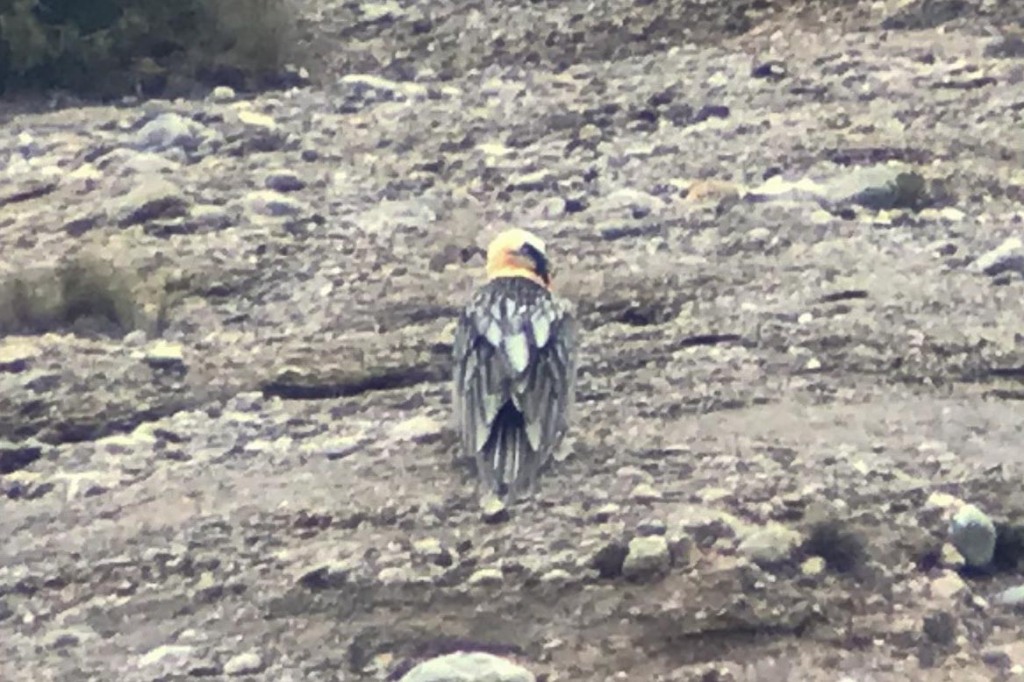
We walked back down from the dam and up through the last tunnel. A Firecrest was calling in the bushes just beyond and a pair of Crested Tits worked their way through the trees above. Another Sardinian Warbler was skulking in the vegetation on the other side of the track but only showed itself very briefly.
Driving back down, we stopped again by the cliffs. A distant Wallcreeper called but despite scanning various rock faces, we could not locate it and we didn’t hear it again. Very frustrating, as this was top of many of the group’s target list. Continuing on a bit further, a small group of Rock Buntings flew up from beside the road. We stopped just beyond and they quickly came back in. It seemed like they wanted to feed on the verge but wouldn’t stay out in the open now. They landed in the bushes on the other side of the road, perched nicely for a few seconds where we could get a good look at them, then disappeared into the vegetation higher up the slope. Rock Buntings have apparently been very scarce in the Pyrenees over the winter, so this was one we had thought we might miss on this trip – something by way of compensation. The cloud was breaking and it was starting to warm up nicely now – we looked back towards the hill tops to see lots of the Griffon Vultures circling up.
On our way back to the main road, we stopped again where a Goshawk was perched in some trees in a dry riverbed. A young male, it had its white undertail coverts puffed out. When a second Goshawk appeared in the trees nearby, the first took off and started a quick burst of slow flap display, before the two of them both disappeared back down into the trees. We stopped for coffee at a filling station on the main road where a Hummingbird Hawkmoth was fluttering against the windows.
MonteAragon castle was closed for repairs and we couldn’t drive up to the top today, so we parked at the bottom to walk up. A Little Owl was perched in a gnarled tree on the low cliffs opposite and a smart male Blue Rock Thrush was higher up on the rocks, the first of many we would see today. The sun was out and more Griffons were moving now, presumably riding the thermals out over the plains from the hills. An Egyptian Vulture circled overhead too.
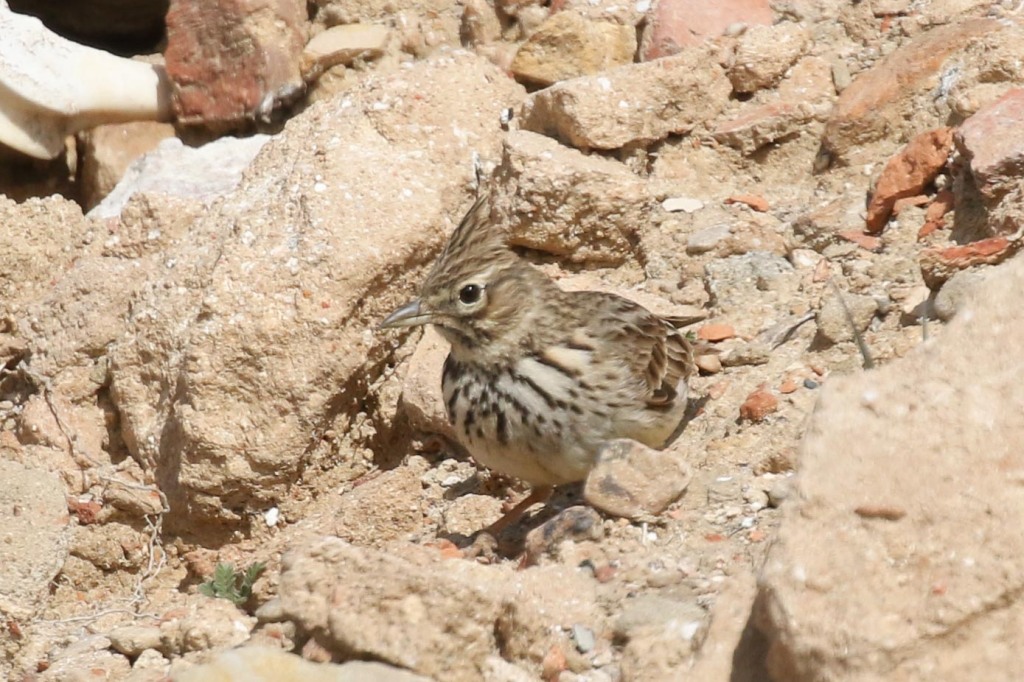
As we walked up the road, we stopped for a quick scan of the rocks below. A pair of Black Wheatears flicked up the valley away from us, flashing their white tail bases, and a Dartford Warbler flew across the road singing. We heard a couple of Thekla Larks singing, and had nice views of a pair on the rocks by the road further up just below the castle. Several Serins were flying round in and out of the vegetation here and we watched a couple of Black Redstarts flicking in and out of the rocks. In the sunshine, there were lots of butterflies out now – Swallowtails, Small and Bath White, Clouded Yellows and Wall. We walked back down to the cars for a late lunch, where another Dartford Warbler was now following a smart male Stonechat around through the scrub nearby.
We drove round to the beautiful medieval village of Alquezar for the remainder of the afternoon. Every bush seemed to hold several Blackcaps as we walked down from the car park, as well as Song Thrushes and one or two Sardinian Warblers. Into the village, we stopped to look at two Black Redstarts on the roofs, one a smart male. Down at the gorge, there were lots of Griffon Vultures and Ravens up now, and Red-billed Choughs flying back and forth from the monastery. A very close Egyptian Vulture circled over right in front of us and later on we watched a pair on the top of a nearby rocky outcrop mating. Not an everyday occurrence!
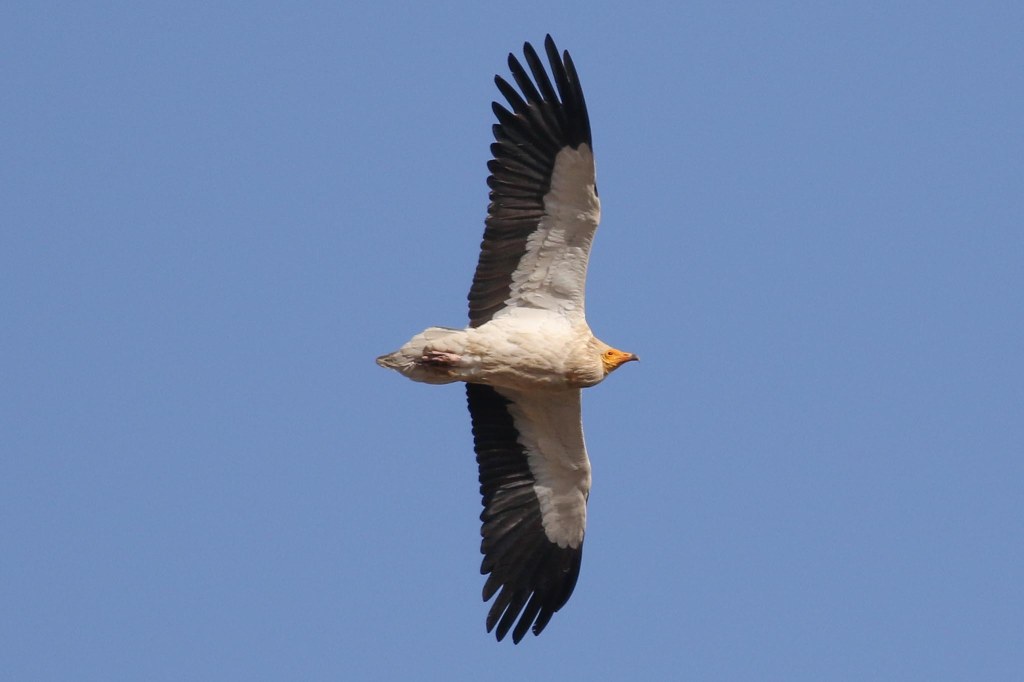
It was a lovely place to stand and watch the climbers tackling the rock faces. There were several more Blue Rock Thrushes here and Crag Martins in and out of the cliffs, but we were out of luck with Wallcreeper here too today. A Sparrowhawk shot in, almost colliding with us, and scattered all the Blackcaps and Song Thrushes before landing on the railings. A Scarce Swallowtail around the trees below the monastery was an addition to the butterfly list. As the sun started to drop behind the hills and the gorge fell into shadow, several Hawfinches flew up into the tops of the trees. It was time for us to head back.
28th February
With Wallcreeper still top of our target list, we headed over to Mallos de Riglos first thing this morning to see if our luck was in today. We walked up through the village from the car park and out onto the hillside, where a Wren was singing from the bushes. A couple of Crag Martins were flying in and out of the cliffs, Griffon Vultures drifted overhead and a Sparrowhawk zipped across in front of the rocks.
We didn’t have to wait too long and, as if on cue, a Wallcreeper appeared on the rock face above us. It was not too high and we got it in the scopes, watching as it climbed up, flicking its wings. When it disappeared into a cleft behind an outcrop, we walked further round to try to pick it up again and it suddenly dropped vertically down towards the bottom of the face. We walked up towards where it had dropped and found it feeding low down on the rocks. We had fantastic views now as it worked its way towards us and then started to ascend again. The sun was just breaking up the clouds and the morning light was perfect to show off the deep red in its wings as it opened and shut them. Simply stunning! And well worth the wait.
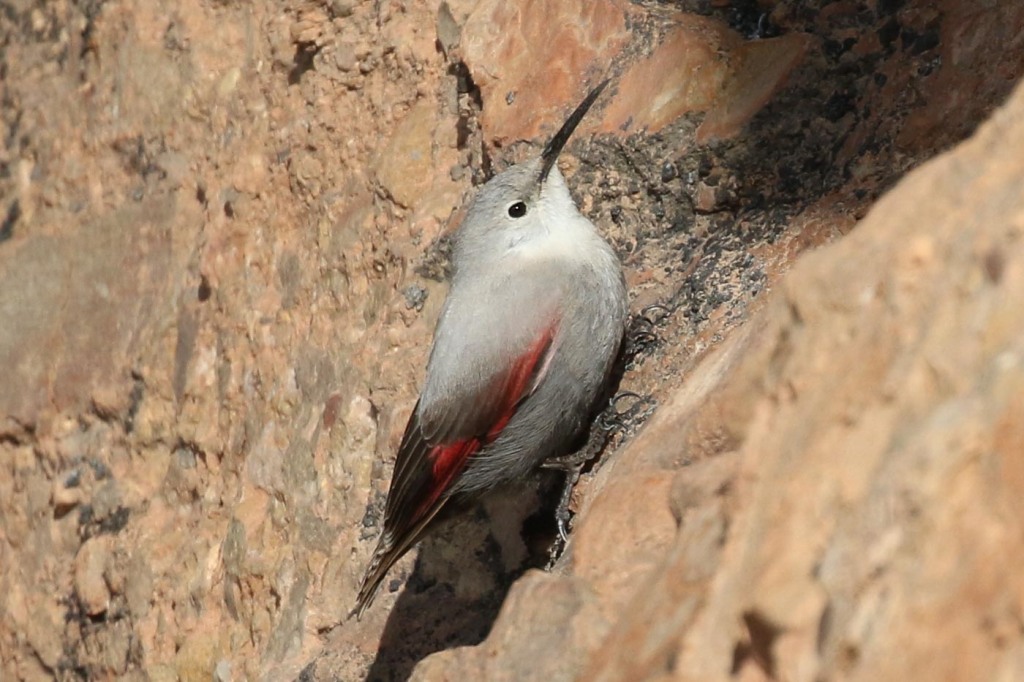
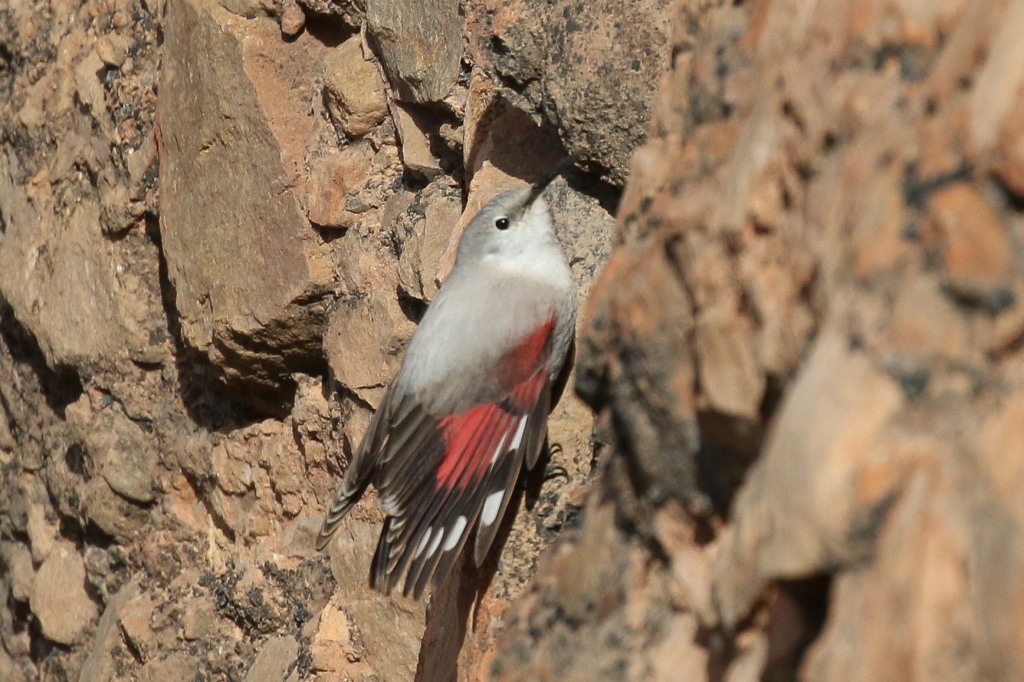
The Wallcreeper eventually flew off round the rock face out of view. We continued to scan, in case it might reappear higher up, but all we could find was a male Blue Rock Thrush. A Cirl Bunting was calling nearby, but only allowed us just a couple of brief glimpses. A Sardinian Warbler in the low scrub was very skulking but finally allowed us some better views. Back at the car park, there were Hawfinches in the tops of the trees just beyond now, Serins calling overhead and a Chiffchaff singing nearby. We walked down to a nearby café for coffee, to celebrate our success. A Song Thrush was gorging itself on fallen olives just across the road, and several Blackcaps and a Sardinian Warbler were feeding on the fruits in the trees above too.
As we drove across towards Jaca next, there were lots of raptors circling up in the sunshine now, more Griffon Vultures, Red Kites, Common Buzzards and one or two Sparrowhawks. We stopped at a picnic area in the pines for lunch, where Crossbills were calling in the trees and flying back and forth overhead. Afterwards, we set off for a walk along a track through the forest. There were Crested Tits, a pair of Nuthatches and Short-toed Treecreepers in the trees in the far end of the picnic area and lots of Chaffinches flew up from the undergrowth along the track beyond as we approached, with Bramblings calling here too.
We hadn’t gone too far, when a Black Woodpecker appeared through the trees and flashed past us. We tried to follow it, getting some great flight views and some briefer views of it perched on the trees. An impressive bird, the largest of the European woodpeckers. Eventually it settled and started drumming on a dead tree deeper in. Now we realised there were actually two Black Woodpeckers – the male drumming one way and a female calling back along the track. It was great to hear them too.
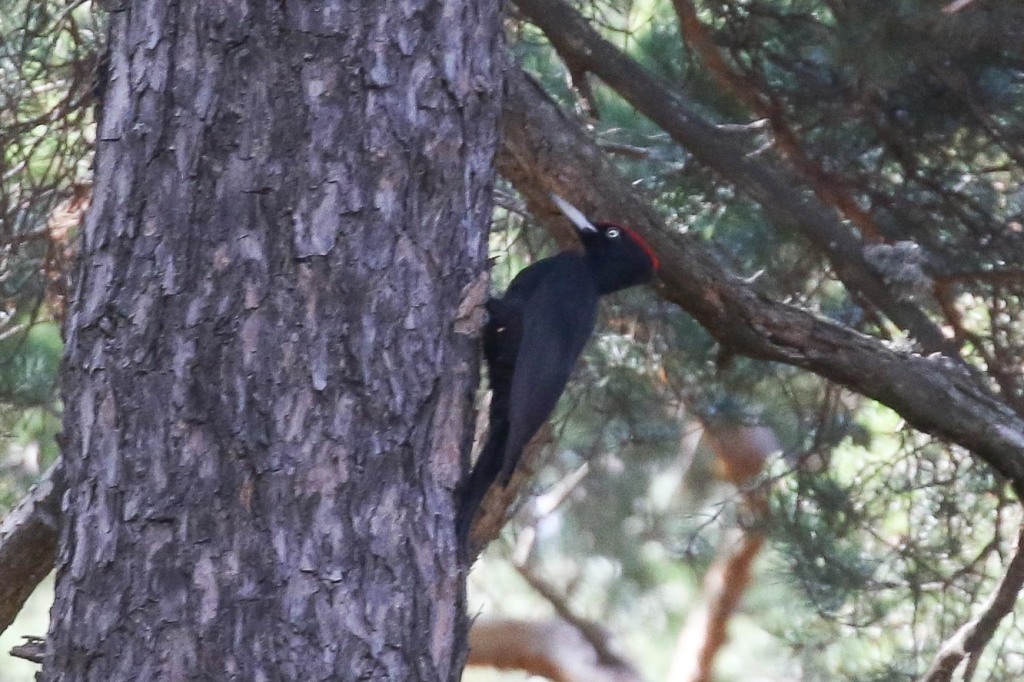
While we were watching the woodpeckers, we heard Common Cranes calling high overhead, migrating north from their wintering grounds further south in Spain, heading for northern Europe. On the way back to the picnic area, we stopped again where the Chaffinches were feeding on the ground and this time managed to pick out one or two Brambling with them out in the open. A Bullfinch was calling from the trees beyond the car park and we had great views of Crested Tits on the edge of the parking area now too.
From here, we carried on up above Jaca to the ski stations at Astun and Candanchu. Once again, it was surprising to see how little snow there was, with clear patches right up around the tops. Given that, it was perhaps not surprising that there was no sign of any Alpine Choughs hanging around the resorts here now – they had presumably already moved off into the surrounding mountains. We decided not to linger and dropped back down to make one last stop by the river on the way. From the bridge, we could see three Dippers and a Grey Wagtail on the rocks below. The valley was in shade now but the sun was still on the crags high above. Two Golden Eagles and a Lammergeier appeared with the Griffon Vultures circling above and several Alpine Choughs chased around the peaks. That’s where they were! Then we had to call time and head back.
1st March
After packing up, we headed down from the hills and out onto the plains today. There were lots of Corn Buntings and Spotless Starlings on the wires, Marsh Harriers, Common Buzzards and Red Kites over the fields, and White Storks on their nests. Six Black-bellied Sandgrouse flew up from a field by the road as we passed and we stopped to look as they landed again. There were loads of Calandra Larks singing out in the fields here and a few Lapwings too.
We turned onto a track and stopped on a ridge to scan the surrounding countryside. We picked out a distant Iberian Grey Shrike and a couple of Red Foxes. We were hoping for Great Bustard, but we could’t see any in the fields here today. Then, as we were just about to give up, we picked one up flying in towards us. We watched as it flew past and disappeared off over the hillside beyond. We tried another track, which produced our first Hoopoe of the trip flying over.
We had planned to move on quickly from here towards Belchite, but we found the road closed now, so we had to take a long diversion round via Bujaraloz. We stopped for coffee in the village there and afterwards had a quick quick look at a couple of nearby small ponds. The reeds were alive with Chiffchaffs and there were lots of finches in the surrounding trees, mostly Chaffinch and Greenfinch but with one smart male Brambling too. A Grey Wagtail flew up from the water’s edge and a Cetti’s Warbler sang from deep in the reeds.
A quick drive round the surrounding fields failed to produce any more Great Bustards or sandgrouse. A tractor was ploughing the field where we had been told some bustards had been in the last few days and it was just full of White Wagtails now. There were several Red-billed Choughs feeding in a nearby wheat field and a single Barn Swallow flew over, heading north.
Continuing on towards Belchite, a Black Kite circled over the road with a White Stork and there seemed to lots of Red Kites on the move along the Ebro valley. We picked up a small flock of Common Cranes high over the road as we passed. It was obviously good weather for migration today, in the sunshine.
We stopped for lunch overlooking a small area of steppe. It was unseasonably warm now in the sunshine and the birds had largely fallen quiet. A distant Crag Martin patrolled along the top of a ridge. After lunch, we had a short walk out along a path across the steppe. There were just one or two Calandra Larks singing, although we did see and hear our first Mediterranean Short-toed Lark songflighting (the lark formerly known as Lesser Short-toed Lark, it was split into two separate species only last December with the ones here now to be known as ‘Mediterranean’). We also had a very brief glimpse of a Dupont’s Lark, which flushed from the side of the path, but it dropped back out of sight into the vegetation before anyone could get onto it.
<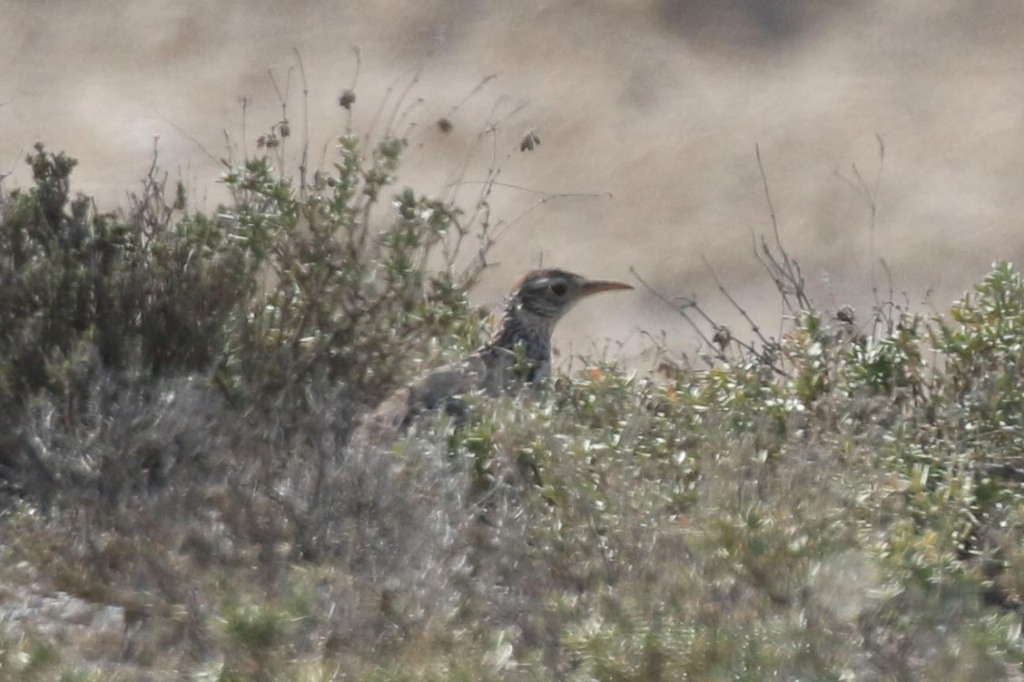
Back to the cars and we drove on, before turning off the road onto a track. We didn’t have to go too far before a pair of Dupont’s Larks appeared in the low scrub close by. We watched them running across the gaps between the clumps of vegetation, stopping with their necks stretched up and showing off their long downcurved bills. As the patch they were in narrowed towards the road, they eventually flew back across a cleared area behind and disappeared. Dupont’s Lark is restricted to parts of Spain and North Africa, and Belchite is one of the best places to see them, so this was one of the key birds to see while we were here. We carried on along the track and stopped again further up to scan. There were lots of Calandra Larks and Mediterranean Short-toed Larks here now, and Red-legged Partridges.
We made our way into Belchite and stopped for coffee at the filling station. Afterwards, we headed out of town to check out the stony fields, hoping to find more sandgrouse. Some huge flocks of Calandra Larks here made for an impressive sight. A Black Redstart flew out of a lone bush by the road as we turned onto a side track. But the award for surprise of the day goes to a Goshawk flushed from the shade behind a ruined barn – it seems very odd to see one out in the middle of the open plains – and flew off carrying whatever it had been in the process of eating. A ringtail Hen Harrier circled over the ridge in the distance beyond and two Golden Eagles flew up, one continuing across the road in front of us before landing on a pylon a couple of fields over. When we stopped to get it in the scope, we noticed three Stone Curlews in a nearby field. As we got back to the main road, we flushed several Black-bellied Sandgrouse from the fields now, but there was still no sign of the hoped for Pin-tailed.
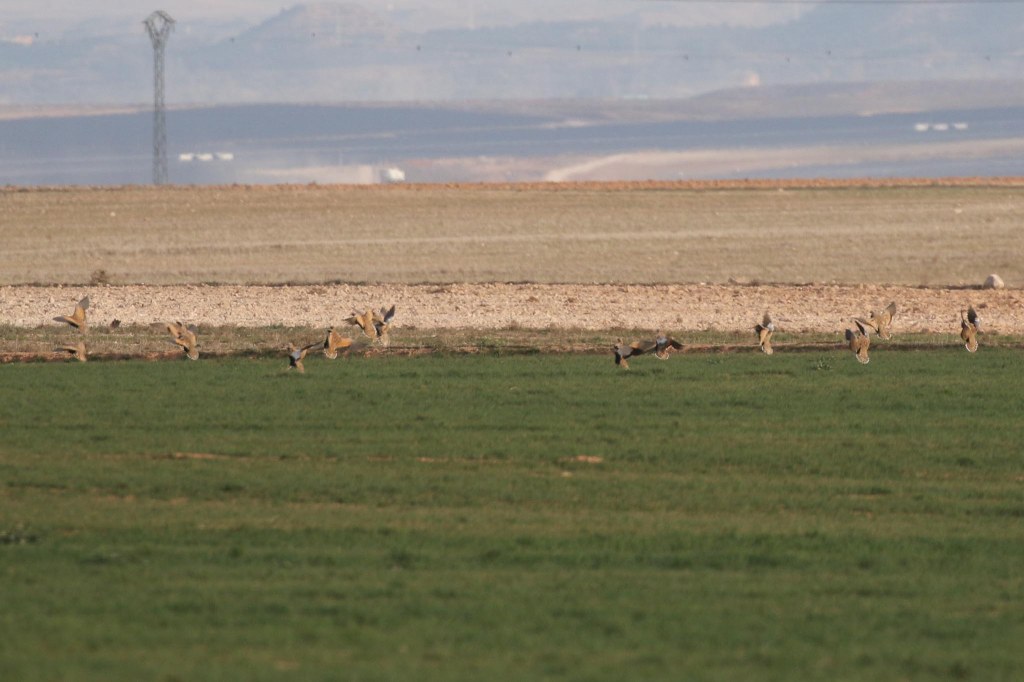
We headed down to El Planeron to finish the day, hoping to catch the Dupont’s Larks singing at dusk. The sun was starting to go down, but having disappeared behind thin cloud, the temperature was already dropping quite fast. We were disappointed to find it was still unusually quiet out on the plains. There were just one or two Calandra Larks and Mediterranean Short-toed Larks singing, and nothing from the Dupont’s. We picked out a Little Owl and a Black Redstart in the distance on the roof of an old barn. Four Black Kites flew over low, presumably heading off to roost, stopping off on their journey north. A male Hen Harrier flew past and landed in a distant field to eat the prey it had just caught. Another Iberian Grey Shrike was perched in a tree and we got it in the scope for a closer look. Then before we got too cold, we decided it was time to head back.
2nd March
After breakfast, we packed up for last time. As we loaded the cars, a male Serin was singing in a bare tree in the courtyard, showing off its yellow rump. We were disappointed to find that a thick fog had descended overnight. We had planned to go back to El Planeron this morning, hoping to hear the Dupont’s Larks singing, but it wouldn’t be worth it now. Instead, we drove down to a small pool behind the village hoping we might catch up with a Pin-tailed Sandgrouse instead coming in to drink. We didn’t, just a distant Black-bellied Sandgrouse in a nearby field. But while we were scanning, we did pick up at least five Hen Harriers out here as well as a couple of Marsh Harriers, plus several Iberian Grey Shrikes, a Little Owl and a Hoopoe flying over. Even better, the fog was burning off quicker than we thought and the Calandra Larks, Crested Larks and Corn Buntings were all starting to sing.
The fog was lingering in the valley and we could see it would be foggy still at El Planeron, so we decided to try an area of steppe higher up which we could see was now clear. As we drove in along the track, we hadn’t gone too far before we heard two Dupont’s Larks singing. Both were some way off the track though, so we knew we would have no chance to see them. After a quick listen, we continued on, and stopped again at the top of a ridge where we could get out. Another Dupont’s Lark was singing in the distance and several Mediterranean Short-toed Larks were song flighting overhead too, so we stood and listened.
We heard Pin-tailed Sandgrouse calling in the distance and looked across to see three flying over. They circled round and dropped down behind a ploughed area back down by the track, so we drove back that way and got out to see if we could find them. There was no further sign of the sandgrouse now, but we could hear another Dupont’s Lark singing nearby which sounded like it was closer to us. We walked further back along the track, but despite scanning the area of scrub it was in with scopes we couldn’t find it. We didn’t want to disturb it, so we just stood and listened – great to hear its slightly discordant song. We heard Common Cranes bugling and looked up to see a couple of long lines which came high overhead, about two hundred in all.
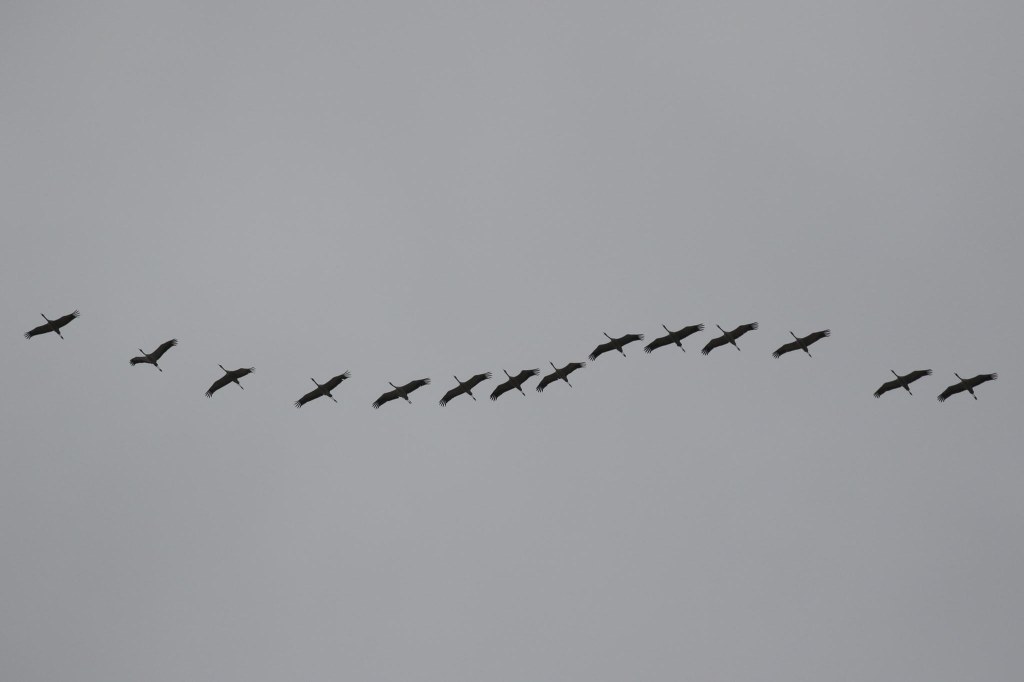
We had to be back at the airport later this afternoon, so we headed down towards the coast now. We had a quick stop for coffee, and to admire the ancient hilltop city of Morella while we refueled below. We made another impromptu stop a little further down to look at a herd of Iberian Ibex in fields by the road, before they ran off up into the hills beyond. A couple of Woodlarks were singing above them. There were lots of Corn Buntings feeding in the fields here too, plus a pair of Cirl Buntings and several Rock Sparrows.
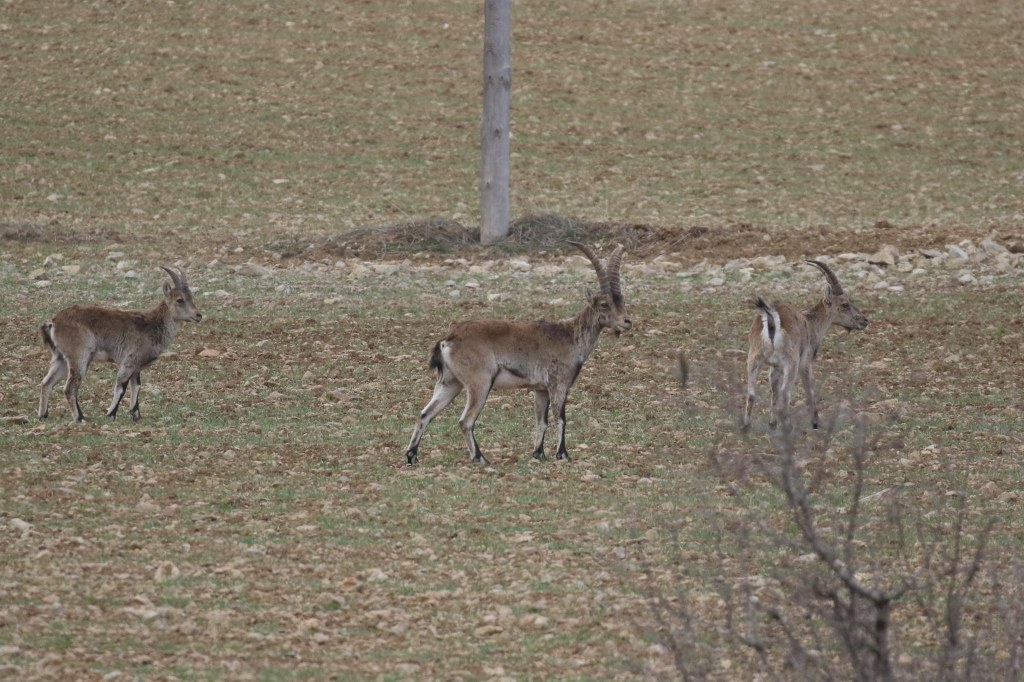
On our way out into the Ebro Delta, we stopped to look through the gulls in the marina – lots of Yellow-legged and Black-headed Gulls, and three smart Audouin’s Gulls in amongst them, one on the water and two on the roof of a nearby building. Several Coot were also an addition to the trip list here too. Continuing on, we stopped again to look at lots of Greater Flamingoes feeding in the saltpans by the road, always a pleasure to see. A Caspian Tern flew past and scanning with the scopes we picked up a couple of Great Crested Grebes and a distant flock of Mediterranean Gulls on the water beyond. There was a good selection of waders on the pools here too – several Little Stints in with the flocks of Dunlin, a handful of Kentish Plovers, Grey Plovers and Ringed Plovers, lots of Redshank and a few Greenshank, Turnstones and Common Sandpipers. A Sparrowhawk flew low across over the pools and scattered everything.
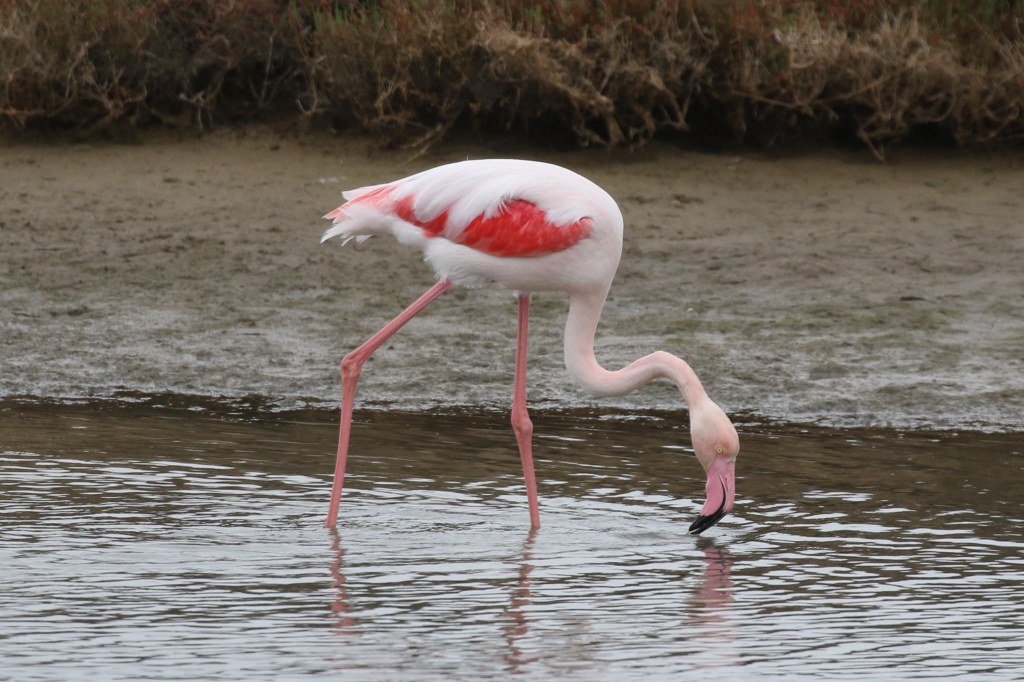
Unfortunately, we were out of time. We turned to see rain approaching and a couple of large flocks of Glossy Ibis flying over the fields in the distance. Back in the cars, we set off for the airport. A Eurasian Curlew flushed from a field as we passed. There were a few Glossy Ibis in the channel by the road, but they flew when we pulled up. A little further on, more Glossy Ibis in a wet field were more obliging. There were a couple of Green Sandpipers and several Water Pipit here too, but we had to tear ourselves away, and make a quick dash through the rain back to Barcelona so as not to be late for our flight. We arrived just in time, dropped off the hire cars, said our thanks and farewells to Carles and then had to queue for an hour to check in. When we finally got on board, the flight back to Gatwick was uneventful and we arrived back on time, late that evening, with some very happy memories of the trip.
















